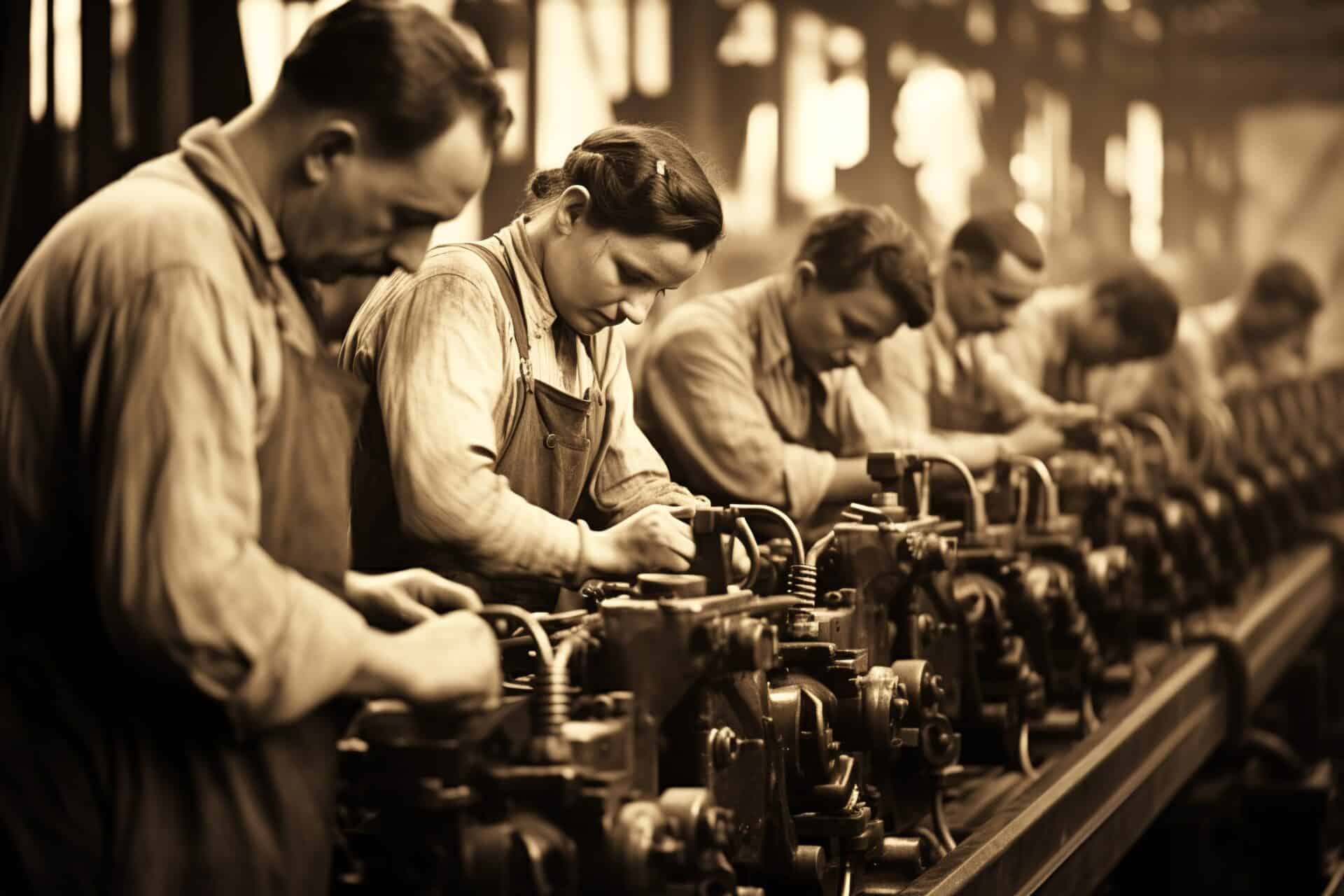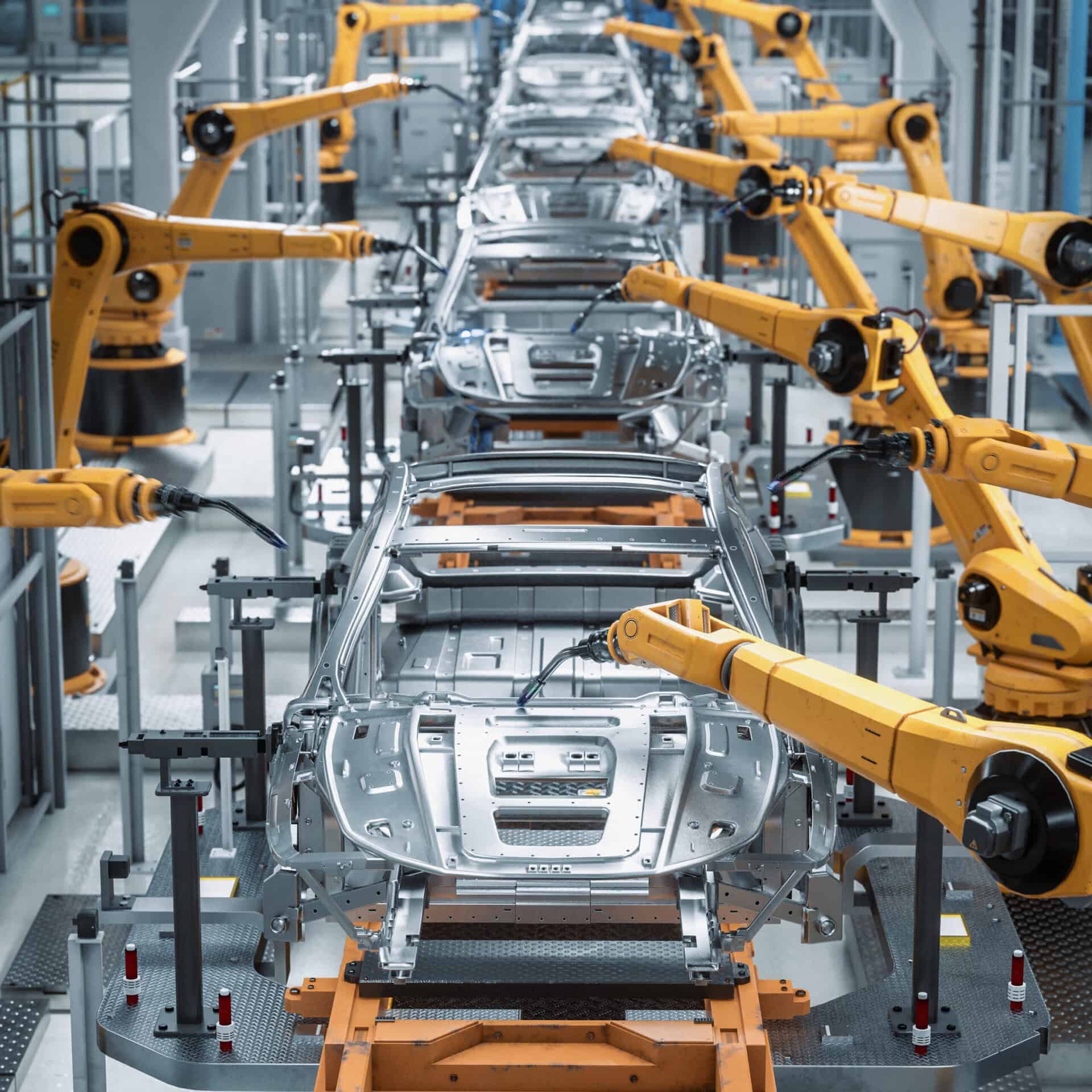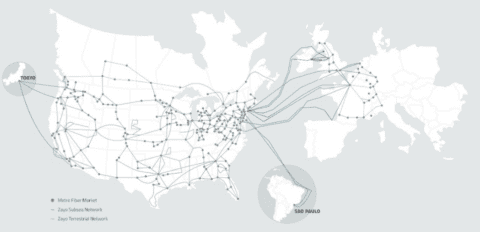What’s a Factory Today?
Not Your Grandfather’s Detroit

Factories are special places. When we think about “the factory,” some of us still have the old Henry Ford assembly lines in mind. Revolutionary for its time, people performed repetitive tasks in a predictable and continuous, conveyor-belt-driven flow, breaking important ground in efficiency, industrialization, standardization, output, and profit.
It worked well, except when it didn’t:

Humans are, after all, not robots, and there was just no room on the conveyor for the flexibility and variable performance accommodations we all need. With human involvement, production slows.

Fast forward a century, and we have a very different picture. People have been replaced by robots for those repeatable tasks, further honing the near-perfection of each part’s placement.
Intelligent software replaces poring over spreadsheets, so inventory and production meet demand almost exactly. Product quality is ensured as it’s managed to pinpoint precision.
Lean, clean, safe, productive, and flexible.
And now, computer intelligence (read: AI) is unlocking the true value of IoT and automation. Without AI, IoT and automation were fairly decent workers. They provided the eyes, ears, skin, and muscle working on a task. The brains that programmed and monitored their work? Those were still human.
AI is the force multiplier – the brains of the operation – that will find the efficiencies and will provide the automation to act on what it finds.
At this inflection point, we must consider the production implications of the speed, precision, and intelligent output of not only goods, but ideas and strategies, plans and processes. And ultimately, what are the network implications when computers do our thinking?
Enter AI – The Genie That Cannot Be Put Back Into the Bottle
Manufacturing may not look like Henry Ford’s conveyors any longer, but we are experiencing an unmistakable groundswell of “factory” like production, both in our physical economy and our digital economy.
- The factories of our physical economy produce physical goods, and use physical transportation methods to bring raw parts to the place of production.
- The factories of our digital economy are our data centers, and use a digital supply chain (the network) as their transportation.
And artificial intelligence is transforming not just digital and physical factory floors, but entire supply chains. AI now powers critical functions such as predictive maintenance, faster decision-making, demand forecasting, and even emotionally aware customer chatbots. IoT devices ensure factories remain interconnected, collecting and analyzing real-time data to boost operational efficiency.
To maximize the benefits of this tech, factories of all kinds need networks capable of processing vast amounts of data with the lowest latency possible, ensuring real-time insights and uninterrupted workflows.
When Humans Split the Scene, Things Get FAST
How fast will our networks need to run when machines chat only with each other?
Factories (physical and digital factories) are at the very edge of digital transformation. They’ve consistently led the way, showing us what happens when we put our trust in technology.
If humans are still involved in the collection or analysis of the data – at either end of the transaction – network speed is less relevant, because humans don’t process quickly. However, humans are being removed from transactions altogether.
When humans get out of the way and we leave the decision-making, the computational analyses, and our daily transactions in the hands of our machines, we find a new need for network speed.
The merging of physical and digital economies requires an underlying digital infrastructure. The data center is where physical and digital means of production merge. The connectivity data centers needed in the past are the requirements of the factory today.
It is becoming apparent that traditional network infrastructure is ill-equipped to handle this surge in multi-cloud information flow. A 50 Mbps connection to the Internet is no longer sufficient and 10 Gbps is barely table stakes. Factories require fiber connectivity and the huge bandwidth it enables.
Why?
- Because data is now bigger than factories have ever seen
AI models need training. They use all available digital information to learn and infer. Plus, the power of AI lies in its ability to connect the dots – to analyze large datasets, correlate the data, identify patterns, and provide insights with more data-driven precision than mere mortals can. - Because data needs new distribution patterns
Factories have adopted a multi-cloud architecture. Data is shared among public and private clouds, on- and off-premises. Critical data needs failover paths. Can today’s networks orchestrate the good, intercloud communication that allows AI to draw sounder conclusions? - And because this explosive volume of data still needs to perform well
You need a networking environment that scales easily (to accommodate all that data storage and processing). Plus, the more data you’re processing, the more you need to think about security, including encryption, access control, threat detection, and attack protection. - And you need that network to be quick as a whip. In fact, much quicker than that. (If the crack of a whip occurs at Mach 2 – twice the speed of sound – data needs to move literally one million times faster: at the speed of light.) Factories relying on AI applications require real-time processing. With the lowest latency possible.
As factories lead the way in adopting this new category of machine assistance (assistants?), they also need to prepare their networks to provide an accommodating and responsive digital infrastructure for the incoming.
Fiber to the Factory
Networking capacity is barely keeping up with the demands of data. Breaking the bottleneck means more capacity, delivered faster.
With its lightning-fast speeds and unparalleled reliability, fiber will be the foundation of this data-driven era. The bandwidth fiber provides is limited only by the equipment placed on either end. So the potential fiber holds is immense – from enabling real-time communication between machines to powering advanced analytics systems that would optimize production lines.
The impact of fiber on manufacturing processes can be transformative. Factories become digital ecosystems where machines seamlessly communicate with one another, leading to increased automation and reduced downtime. Productivity soars, waste diminishes, and quality reaches new heights.
The network is the new supply chain of the digital economy.
Fiber-equipped factories:
- Are well-positioned to grow.
If we’ve learned anything, we’ve learned that more and more bandwidth will be needed to support the data needs of our new factories. Only fiber provides the foundational infrastructure for such growth. - Are connected to the broader ecosystem of support.
The right fiber provider adds considerable value to the fiber – since that fiber will be connected to a broader network that can connect factories to the lattice of destinations and partners in their digital supply chain.
Fiber is the only transmission medium worthy of the task ahead. In fact, within data centers, it’s estimated that AI will generate a need for five times more fiber optic cabling than they currently have.
The Perfect Partner for Your Fiber Upgrade
When looking for a partner to equip your factory with fiber, look for providers with reach, scale, experience, and an appetite for continuous investment.
Fiber Reach
If new fiber is to become the backbone of modern factories, it needs to be where factory data needs to go. We discussed last week that the industrialization of North America is humming at levels of investment not seen since the 1950s. Make sure your provider’s long haul and metro networks reach the production centers important to you.
Fiber Scale
No technology, including fiber, is a one-and-done installation. We didn’t see AI coming, but now it’s here, and it’s hungry for bandwidth.
Fiber Experience
Here, we recommend going to the source: purchase network capacity from a network provider. Life will be easier – you’ll be treated to installation expertise, permitting experience, better customization, faster response times, ensured security, SLAs with teeth, diagnostic expertise, and so much more!
Fiber Investment
If a provider is counseling you to upgrade your fiber network, be sure they take their own advice! Tech moves fast – and when your provider upgrades their own network, they’re meeting increasing demand, supporting new innovations, ensuring quality, and adapting to a factory’s evolving needs. If you’re on the cutting edge, be sure your provider is too.
You’ve got the data. Zayo’s got the experience. Our fiber reach, capacity growth, investments, customized designs, and fast turnaround can ensure that your data flows unimpeded.



